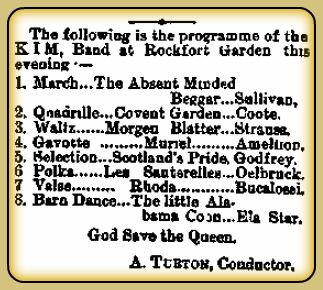Studs Terkel, (1912-2008) February 2008 (BBC interview)

1899 - 1900 how it all started
~~~~~~~~~~~~~~~~~~~~~~~~~~
For about four decades, from 1900 to 1940, Rockfort Gardens was Kingston's most important venue for a wide variety of forms of entertainment; to day it is all but forgotten and the site is occupied by power generating equipment of the Jamaica Public Service Company.
~~~~~~~~~~~~~~~~~~~~~~~~~~
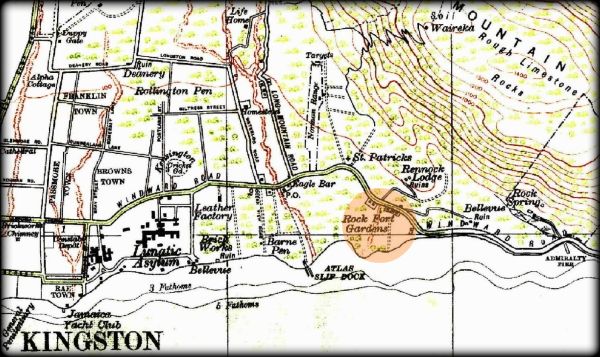
Daily Gleaner, July 19, 1899
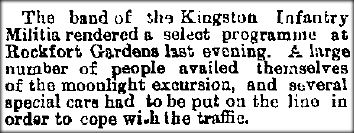
Excursion to Rockfort Gardens
Rockfort Gardens was the scene of intense
animation on Tuesday evening last, the
occasion being the formal opening of the
future recreation ground for Kingston.
From early in the afternoon cars on the
Rockfort route were crowded with
passengers, to such an extent that standing
room was unavailable, and as the evening
wore on the rush to the
Gardens became
larger, and in spite of the fact that several
special cars were put on the line, they were
inadequate to convey all the people, and
several had to return to their homes. The
gardens were lighted with electricity and
presented a beautiful appearance while the
band of the Kingston Infantry Militia
rendered a much appreciated programme of
music from early in the evening until after 10
o'clock. There were also refreshments to be
had on the grounds. Between 4,000 and
5,000 people visited the gardens during the
evening.
Daily Gleaner, July 27,
1899
ROCKFORT GARDENS.
Promises
have been made that the gardens at Rockfort should be of such an
attractive character that
they would become the popular resort of the
people of Kingston, but few believed that the [West India
Electric]
Company had in view the ambitious plans which are now disclosed. The
site is a triangle of
bush between the Windward Road and the sea,
where the road and the shore converge at the Third Mile
stone. When
first acquired by the Company it was an unpromising piece of bush,
the scanty vegetation
of which was parched and bare. Twelve months
hence it will be, if there be no interruption of the
operations now
begun, one of the prettiest spots in Jamaica. A good deal has already
been done. The
bush has been cleaned away and only the more
pretentious trees remain. The ground has been cleaned
up. Two fine
circular pavilions and a band stand have been built. The gardens have
been fenced off. But
still the effect is not very brilliant The
gardens look bare and sombre. Here is order however where
chaos was
before. On Tuesday the first step was taken towards making this order
beautiful, and now
that the process of transformation has begun it will be of interest to give an outline of what the
FUTURE "ROSHERVILLE"*
will be like.
It
should be stated first of all that the laying out of the Gardens has
been undertaken by the Botanical
Departments at the expense of course
of the Tramway Company, Mr. W. Fawcett Director of Public
Gardens and
Plantations has entered heartily into the Company's project, and as a
garden is to be made
he is anxious that it should be one worthy of
the city and one of which Jamaica may be proud. Mr.
Holgate [manager
of the West India Electric Company] has realised the importance of
making the
Gardens representative of tropical plant life and flora of
Jamaica's economic plants. In this way the
gardens will become a
great attraction to tourists who will hail with pleasure so
convenient and pretty a
park where they can see all that is novel and interesting in tropical plant life.
On
Tuesday last Mr. T. J. Harris, of Hope Gardens, visited Rockfort and commenced
the task of
planning oat the gardens. The first step taken was to peg
out a plot in the shape of a heart the apex of
which is about fifteen
yards from the entrance. Paths have been cut out round the sides of
the heart to
the base within a few yards of the central pavilion.
Within the heart all kinds of short decorative trees
and growing
shrubs are to be planted, and the soil is being prepared for the
planting of the shrubs,
which are being sent to the Gardens daily.
The soil proves to be a very fine alluvial deposit and it is
believed
that the park will prove a splendid success from a gardener's point
of view. About half-way
along the point to the left of the apex, it
bifurcates, one branch continuing round the heart to the central
pavilion and the other going straight along westward parallel with
the shore. It ends at the smaller
pavilion within a short distance of
the western boundary of the Gardens. Between this path and the sea,
a
LONG ROW OF ALMOND

the tropical or sea almond, Terminalia catappa L., probably
introduced into Jamaica at the end of the 18th century
trees
is to be planted, the principal purpose of which will be to stem the
ferocity of the south-west
breeze, which would break the more tender
shrubs to be planted. In twelve months the almond trees
will grow
about ten feet and when at maturity will reach about 40 feet. On the
leeward side of the trees
towards the path, strong shrubs are to be
planted and they too will protect the more delicate plants in
the
centre of the park. The effect of this bank of foliage along the path
will be very pretty. The fear may
arise in the minds of some that the
glorious but boisterous ozone is to be excluded for the sake of the
plants. The fear is groundless. Here and there breaks will be made in
the wall of foliage through which
lovers of a blow may go to the sea
front along which seats will run. This frontage commanding as it does
a beautiful view of the harbour, and against which the waves are
driven by the strong south wester that
prevails will be one of the
most attractive delights of the Garden. Before the paths from the
apex of the
heart
meet at the pavilion they will come out upon a beautiful gravel
promenade which
will lead to the
band stand lying between the two pavilions. The
promenade is to be of considerable width and each side
will be lined with seats which will give rest to the promenaders on band nights. It is proposed to have
BAND PERFORMANCES TWICE A WEEK.
As has been stated, the site of the Gardens is roughly speaking a triangle.
The
base at the west end runs from the Windward Road to the sea, and the
sides are formed by the
shore and the road. The entrance is at the
apex and the band stand is near the centre. So that there is a
considerable area from the entrance, along the road, and down towards
the sea not yet accounted for.
This land it is intended to convert
into green sward, bordered by plants, trees and shrubs. The stretch
of
sward will be broken here and there by the luxuriant banyan trees,
under the cool shade of which many
a picnic will in all likelihood be held.
The
well near the central pavilion promises to give an abundant supply of sparkling
water. A pump is
now on the way from America and the fountain will be a boon to visitors.
This
is but a brief outline of the metamorphosis that is to take place.
Arbours are to be built, where
lovers may spoon without dread of the
vulgar eye and other details are to be carried out which will
make the garden the show place of the city.
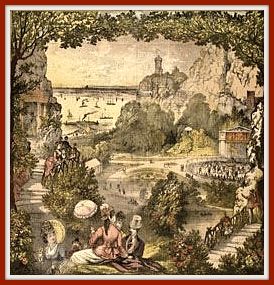
*[Rosherville
Gardens: In
1815 the first steamboat started plying between
Gravesend and London,
an event which was to bring much prosperity to the area.
The number
of visitors steadily increased, and in the course of the next ten
years
several new and rival steam packets were started. With the
regular service given
by the steam packets, amenities for the
entertainment of visitors began to spring
up. One of those amenities was Rosherville Gardens.
The
gardens
were laid out in 1837 by George Jones in one of the disused chalk
pits, covering an area of 17 acres. Their full
title was the 'Kent Zoological and
Botanical Gardens
Institution'. They occupied an area in what was to become
Rosherville New Town.
A
pier was built to carry these crowds ashore, and a railway station
opened on
the Gravesend West branch railway. It was one of the
steamboats from
Rosherville
Gardens
that was involved in a horrific accident in 1878.
The
Rosherville Gardens, on what was previously a barren tract of chalk
pits,
on the estate of an enterprising person of the game of Jeremiah
Rosher, are
highly picturesque grounds of about 18 acres, constantly
open for a small
admission fee, and possessing a rich combination of
attractions, variously
natural and artificial. Tea gardens, taverns,
archery grounds, gipsy tents,
abundant lodging houses, salubrious
air, cheap living, good bathing appliances,
the stir on the river,
fine rambling. grounds in the neighbourhood, and ready
communication
by steamer and by railway with London, also draw hither a great
and
constant concourse of visitors. The town is full of these during all
the
summer months, and absolutely swarms with them on Sundays.]
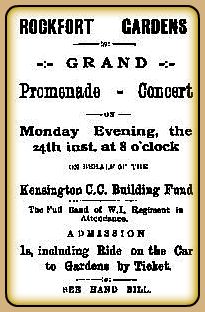
Daily Gleaner, February 7, 1900
